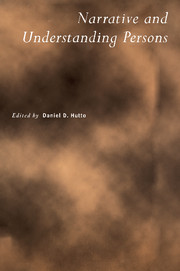Book contents
- Frontmatter
- Contents
- List of Contributors
- Notes on Contributors
- Narrative and Understanding Persons
- Framing Narratives
- The Narrative Practice Hypothesis: Origins and Applications of Folk Psychology
- Dramatic Irony, Narrative, and the External Perspective
- Episodic Ethics
- On the Distance between Literary Narratives and Real-Life Narratives
- Reasons to be Fearful: Strawson, Death and Narrative
- Stories, Lives, and Basic Survival: A Refinement and Defense of the Narrative View
- Self and Other: The Limits of Narrative Understanding
- Pathologies in Narrative Structures
Reasons to be Fearful: Strawson, Death and Narrative
Published online by Cambridge University Press: 04 May 2010
- Frontmatter
- Contents
- List of Contributors
- Notes on Contributors
- Narrative and Understanding Persons
- Framing Narratives
- The Narrative Practice Hypothesis: Origins and Applications of Folk Psychology
- Dramatic Irony, Narrative, and the External Perspective
- Episodic Ethics
- On the Distance between Literary Narratives and Real-Life Narratives
- Reasons to be Fearful: Strawson, Death and Narrative
- Stories, Lives, and Basic Survival: A Refinement and Defense of the Narrative View
- Self and Other: The Limits of Narrative Understanding
- Pathologies in Narrative Structures
Summary
When attempting to face the prospect of one's own death, it has been said that ‘the mind blanks at the glare’. Perhaps we should not treat our attitude towards our death as rational or reflective of our views on the self and on life. But to exempt views on death from the scrutiny of rational discourse seems to be a last resort (albeit one we may need recourse to in the end). There is a general tendency to neglect death within those discussions of the self that fall outside the confines of a certain strain of continental thought roughly construed, or at best to treat it as a topic that resides beyond the borders of the rational. I do not aim to rectify this situation here, nor do I think it obvious that death is something that can be clearly and consistently dealt with by those theories of persons and selves that primarily represent, to use Thomas Nagel's words, ‘an internal view that sees only this side of death—that includes only the finitude of [one's] expected future consciousness’. But I do believe that those who have spent a good deal of time thinking about the life of the self ought to spare a thought or two for its demise, and that such thoughts may contribute to our over-all assessment of their view.
I will compare and assess what two significant and opposing approaches to the self have to say about death.
- Type
- Chapter
- Information
- Narrative and Understanding Persons , pp. 133 - 154Publisher: Cambridge University PressPrint publication year: 2007



